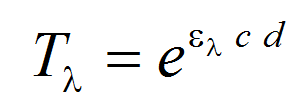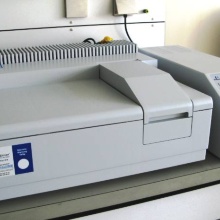The UV/Vis spectrometer Lambda 25 is equipped with a deuterium and a tungsten lamp giving access to wave lengths in the range of 190 nm to 1100 nm [1]. A detector measures how much light is transmitted through a sample of thickness d which according to Lambert-Beer’s Law is related to the sample’s concentration c. It holds for the transmission Tλ at a certain wave length λ 
where ελ is the extinction coefficient.
However, in our group the UV/Vis spectrometer has a special application. It is used to study the phase behaviour of microemulsions – particularly in gelled state. Furthermore, the clear-points of water-surfactant mixtures are measured. For these applications the temperature-controlled cell holder PTP-1 is mandatory in combination with a specific software, TempLab. The latter allows to program heating or cooling rates and cycles during which the transmission of the sample is monitored. Plotting the transmission values versus temperature then allows to identify different phase regions of an investigated mixture. If the sample is phase-separated, e.g. in a two-phase state, it appears turbid which is reflected by low transmission values. In temperature ranges where the sample is one-phase, in contrast, a comparatively high transmission is measured. Eventually, the temperature(s) at which the transmission of the sample changes dramatically mark(s) the phase transmission temperature(s) we are interested in. Thus, this technique is complementary to the conventionally carried out visual phase studies in thermostated water basins. The advantages of using a UV/Vis spectrometer are the possibility of performing automated measurements and, even more importantly, the quantification of the “turbid”/“clear” appearance of a sample which, especially for gelled microemulsions, is often ambiguous.

Diana Sottmann
CTA


